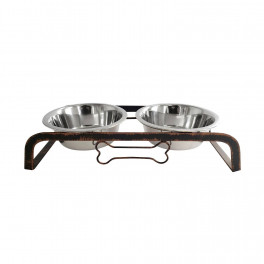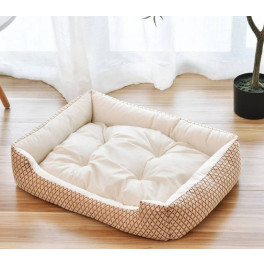You probably don’t think much about the floors in your home until you get a dog or cat and quickly realize that pets are tough on floors. Cats like to scratch, and a dog’s nails can quickly ruin hardwood flooring and carpeting. Animals also tend to track in dirt. Hard floors such as stone and tile can be dangerous for your pet as they may have a difficult time keeping their footing and can fall and injure themselves. If you’re building a new home, renovating a room, or just wondering what you can do to make your floors more pet-friendly, the following information should help you decide on the best pet-friendly flooring options for you and your four-legged friend.
Carpeting
Although many people dislike carpeting, it’s one of the safest and most comfortable options for all pets. Carpet offers secure footing and a warm place for your dog or cat to lay on. Several carpet companies now offer carpeting that’s manufactured specifically for pet owners. The carpet is stain resistant, easy to vacuum, and features a breathable moisture barrier between the carpet and the floor to help reduce odors from pet “accidents.” The only real downside of carpeting is that’s prone to wear and tear and does require frequent vacuuming. Large dogs with long nails can cause snags and cats that like to scratch can quickly ruin a section of carpet.
Cork Floors
Cork flooring has been around for many years but has not been a popular flooring choice until recently. Cork is considered a green and renewable option because it does not require the cutting of old-growth trees and destruction of forests. Cork comes from the bark of the cork oak tree which can be harvested without harming the tree. Cork offers a soft surface for pets and is great flooring for older dogs with arthritic joints. It’s also quiet when it comes to pet nails. Although not totally waterproof, cork is water resistant and has antimicrobial properties. A cork floor is easy to clean and requires regular sweeping or vacuuming to remove dirt and pet hair. Accidents will need to be cleaned up quickly to prevent staining. The disadvantage of a cork floor for pet owners is that the material is soft. Cats and dogs can quickly scratch up a cork floor.

Photo by Parilov on Shutterstock
Hardwood Floors
Although beautiful, hardwood floors are not the best for pets. Even with many coats of polyurethane, there’s no such thing as a scratch-resistant wood floor finish when it comes to dog nails. If you enjoy large dogs and don’t take care of their nails regularly, your hardwood floors are going to take a beating. In addition to being slippery for pets, wood flooring and water don’t mix well. If it’s not cleaned up immediately, water can cause damage to the finish and the salt crystals in urine can penetrate the wood and create stains and lingering odors.

Photo by VipadaLoveYou on Shutterstock
If you have your heart set on wood, consider bamboo or hard maple. Bamboo wood is one of the most popular flooring options for dog-friendly homes. Its durability and hardness make it more scratch-resistant than other traditional hardwoods such as oak, cherry, and walnut. Hard maple flooring, not to be confused with maple, is also a very durable hardwood. Covering the floor with an area rug is always an option, but this will conceal much of the wood.
Laminate
Laminate flooring has come a long way and looks very similar to hardwood flooring. Laminate flooring is fairly scratch-resistant but can be slippery for older pets. If you’re considering laminate flooring for a room in your home, look for flooring that has some kind of texture to the surface. One benefit of laminate flooring over wood flooring is that it’s water-resistant and very easy to clean. Long, hard nails can scratch the surface which will permanently ruin the flooring. If you don’t like the sound of clicking nails, laminate flooring might not be the best choice.

Photo by Igor Normann on Shutterstock
Stone and Ceramic Tile
Stone and ceramic or porcelain tile floors are very durable and make for a fairly scratch-resistant floor. They are also easy to clean and not damaged by water or pet accidents. Unfortunately, this hard surface provides little comfort and can be very cold in the winter. It can also be slippery for some pets. If you have a large area in your home with tile flooring, such as a kitchen, runner rugs in the high traffic areas can help prevent slips and falls for four-legged and two-legged household members. A soft pet bed is a must for any animal that has to sleep on a cold, hard floor.

Photo by Igor Normann on Shutterstock
Vinyl and Linoleum
Although not as attractive as hardwood or laminate, vinyl and linoleum flooring is a good choice for homes with pets. The flooring comes in rolls or individual tiles. The advantage of tiles is that they can be replaced if damaged. In addition to being affordable, most vinyl flooring has a textured surface which gives your pet good traction. It’s very easy to clean and can stand up to water and abuse from long nails. Linoleum is the best flooring for pets that have frequent accidents. Luxury vinyl tile is a type of flooring that closely resembles stone, slate, ceramic, and wood flooring with a surface your pet will love. If you need waterproof flooring for pets, vinyl and linoleum will work best. Vinyl and linoleum is also the best flooring for cats.

Photo by Julie Vader on Shutterstock
Ways to Minimize Damage to Flooring
Keep your dog’s nails short. If you start trimming your dog’s nails when he is a puppy, he will get used to the procedure. Groomers will also be glad to trim your dog’s nails. Cat nails can also be trimmed. Make sure your cat has a scratching post or two to discourage him or her from clawing at the carpet or furniture.
1. Clean up any spills or accidents as soon as possible. Urine can stain and damage some flooring, but the lingering odor can encourage your dog to use that spot in the future. Place a mat under food and water bowls. Some dogs can be very messy eaters and drinkers.
2. Place rugs and runners in high traffic areas such as hallways and rooms where pets spend a lot of time. Make sure your cat and/or dog have their own furniture and beds so they know where they’re supposed to lie down.
3. Keep your floors clean. Dust and vacuum as needed to remove small rocks and other objects that get tracked inside.
4. Hardwood flooring can be refinished if scratches are light. Most homeowners have their hardwood floor refinished every five to ten years depending on the amount of damage done by everyday wear and tear. Pets are not the only culprits for scuffs and scratches.
When it comes to pet-friendly flooring, there’s no right solution for everyone. For owners of large dogs, long nails can be a real concern. For cat owners, carpeting can be a nightmare. Choose the flooring option that works best for your needs and is one you can live with. We all want our furry friends to be comfortable and safe. It’s their home too, after all.
























